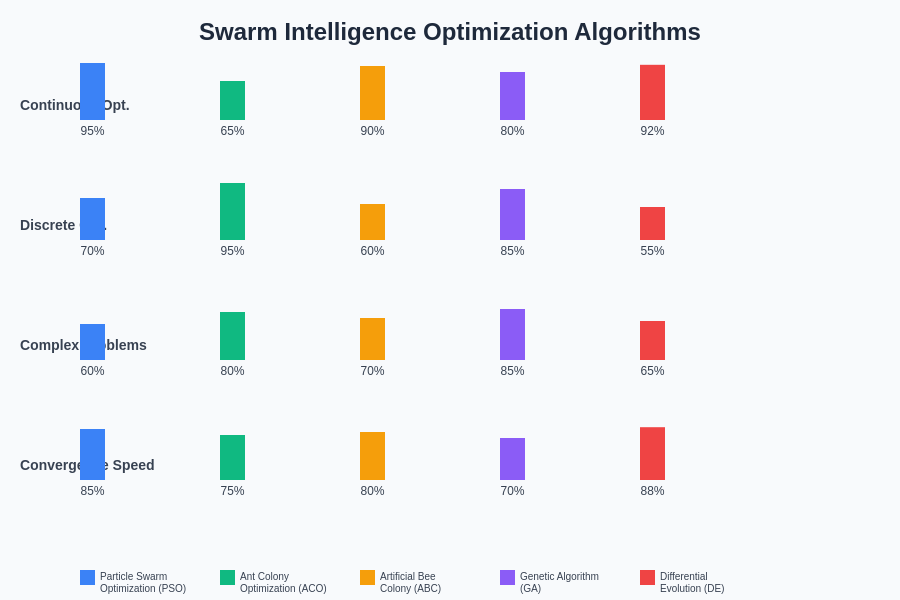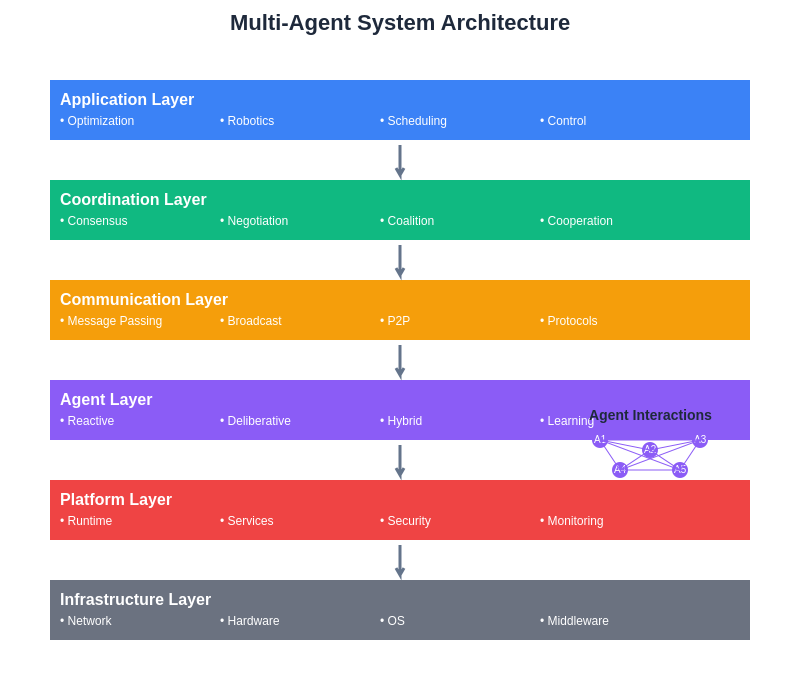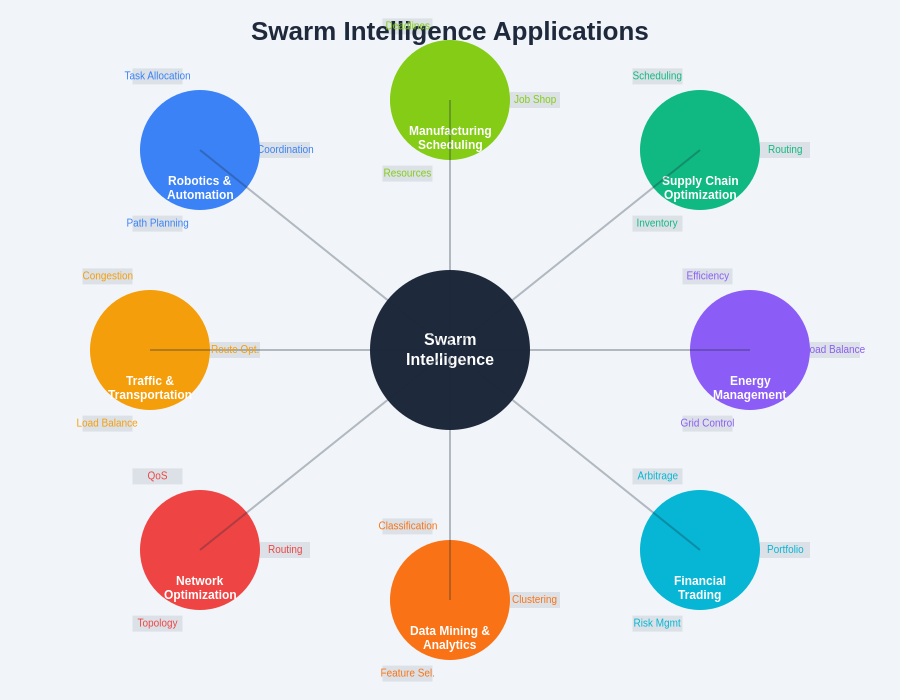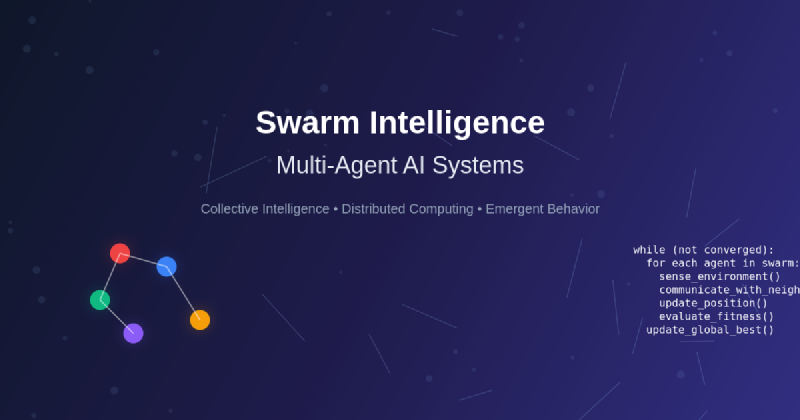The natural world has long provided inspiration for technological innovation, and perhaps nowhere is this more evident than in the emerging field of swarm intelligence and multi-agent artificial intelligence systems. Drawing from the collective behaviors observed in ant colonies, bee swarms, bird flocks, and fish schools, researchers have developed sophisticated computational frameworks that harness the power of multiple intelligent agents working in concert to solve complex problems that would be impossible for individual systems to tackle alone.
Explore the latest AI breakthrough videos to witness cutting-edge demonstrations of swarm intelligence applications across various industries and research domains. The convergence of distributed computing, artificial intelligence, and biological inspiration has created a new paradigm in computational problem-solving that promises to revolutionize everything from logistics and manufacturing to scientific discovery and space exploration.
Understanding Swarm Intelligence Fundamentals
Swarm intelligence represents a computational and behavioral paradigm inspired by the collective behavior of decentralized, self-organized systems found throughout nature. Unlike traditional centralized artificial intelligence systems that rely on a single powerful processing unit, swarm intelligence distributes decision-making across multiple simple agents that interact locally with their environment and with each other according to basic rules, giving rise to complex, intelligent global behavior.
The fundamental principles underlying swarm intelligence include stigmergy, which refers to indirect coordination between agents through environmental modification, positive feedback mechanisms that amplify successful behaviors, negative feedback that prevents system oscillations, and the exploitation of random fluctuations that enable the discovery of new solutions. These principles combine to create systems that exhibit remarkable robustness, adaptability, and problem-solving capabilities that emerge from the collective actions of individual agents rather than being explicitly programmed.
The mathematical foundations of swarm intelligence draw from fields including complex systems theory, graph theory, optimization theory, and statistical mechanics, providing rigorous frameworks for understanding and predicting the behavior of multi-agent systems. These theoretical underpinnings have enabled researchers to develop algorithms and architectures that can be applied to a vast array of real-world problems, from optimizing supply chain logistics to coordinating autonomous vehicle fleets.
Multi-Agent System Architectures
Multi-agent systems represent the computational implementation of swarm intelligence principles, consisting of multiple autonomous agents that can perceive their environment, make decisions, and take actions while communicating and coordinating with other agents in the system. The architecture of these systems typically includes agent platforms that provide the runtime environment for agent execution, communication protocols that enable information exchange between agents, and coordination mechanisms that ensure coherent collective behavior.
The design of individual agents within multi-agent systems involves careful consideration of their sensing capabilities, decision-making algorithms, action repertoires, and communication interfaces. Agents may be reactive, responding directly to environmental stimuli, deliberative, employing sophisticated reasoning and planning mechanisms, or hybrid, combining both approaches depending on the situation and requirements. The choice of agent architecture significantly impacts the overall system performance and the types of problems that can be effectively addressed.
Communication patterns within multi-agent systems can range from direct agent-to-agent messaging to indirect communication through environmental modifications, with each approach offering distinct advantages for different problem domains. The topology of communication networks, whether fully connected, hierarchical, or based on spatial proximity, plays a crucial role in determining information flow patterns and the speed at which collective decisions emerge within the swarm.
Discover advanced AI capabilities with Claude to explore sophisticated multi-agent coordination strategies and develop custom swarm intelligence solutions for complex optimization and decision-making challenges. The integration of advanced reasoning capabilities with distributed agent architectures opens new possibilities for creating intelligent systems that can adapt and evolve in response to changing environmental conditions.
Biological Inspirations and Natural Examples
The development of artificial swarm intelligence has been profoundly influenced by careful observation and analysis of collective behaviors exhibited by various biological systems. Ant colonies demonstrate remarkable optimization capabilities through pheromone-based communication, enabling them to discover shortest paths between food sources and their nests through a process known as stigmergic optimization. This natural algorithm has inspired the development of ant colony optimization techniques that have been successfully applied to traveling salesman problems, network routing, and scheduling challenges.
Bee colonies exhibit sophisticated decision-making processes for selecting new nest sites, involving scout bees that evaluate potential locations and communicate their findings through waggle dances that encode information about distance, direction, and quality. This collective decision-making process ensures that the colony selects optimal locations while distributing the cognitive load across multiple individuals, inspiring the development of artificial bee colony algorithms for continuous optimization problems.
Bird flocking behavior demonstrates emergent coordination through simple local rules governing separation, alignment, and cohesion, resulting in complex group dynamics that enable efficient navigation, predator avoidance, and resource discovery. These principles have been translated into particle swarm optimization algorithms that excel at exploring high-dimensional search spaces and finding global optima in complex optimization landscapes.
Fish schooling behaviors showcase the power of collective sensing and information integration, where individual fish respond to local environmental cues and neighbor behaviors to create coherent group movements that enhance survival and feeding efficiency. These natural systems have inspired the development of distributed sensor networks and collective robotics applications where multiple agents must coordinate their actions to achieve common objectives.
Applications in Optimization and Problem Solving
Swarm intelligence algorithms have proven exceptionally effective for solving complex optimization problems that traditional computational approaches struggle to address efficiently. The distributed nature of swarm-based optimization enables parallel exploration of solution spaces while avoiding many of the pitfalls associated with gradient-based methods, such as getting trapped in local optima or requiring differentiable objective functions.
Particle swarm optimization has become one of the most widely adopted swarm intelligence techniques, successfully applied to problems ranging from neural network training and feature selection to power system optimization and financial portfolio management. The algorithm’s simplicity, effectiveness, and minimal parameter requirements have made it a popular choice for practitioners across diverse domains who need robust optimization capabilities without extensive algorithmic expertise.
Ant colony optimization has found particular success in discrete optimization problems such as vehicle routing, job shop scheduling, and network design, where the stigmergic approach naturally maps to problems involving path selection and resource allocation. The algorithm’s ability to balance exploration and exploitation while maintaining solution diversity has made it especially valuable for problems with dynamic constraints or multiple objectives.
Artificial bee colony algorithms have demonstrated superior performance on continuous optimization problems, particularly those involving high-dimensional search spaces or multi-modal objective functions. The algorithm’s combination of exploitative local search around promising solutions and explorative global search for new regions provides excellent balance for complex optimization landscapes.

The performance characteristics of different swarm intelligence algorithms vary significantly depending on problem structure, dimensionality, and constraint complexity, making algorithm selection a critical consideration for successful application development.
Robotics and Autonomous Systems Integration
The integration of swarm intelligence principles into robotics and autonomous systems has opened entirely new possibilities for coordinated multi-robot applications that can achieve objectives impossible for individual robots to accomplish alone. Swarm robotics systems demonstrate remarkable capabilities in tasks such as environmental monitoring, search and rescue operations, construction and assembly, and distributed sensing applications.
Multi-robot coordination for exploration and mapping tasks leverages swarm intelligence algorithms to optimize coverage patterns, minimize redundant exploration, and ensure efficient information sharing among team members. These systems can adapt dynamically to environmental changes, robot failures, and evolving mission objectives while maintaining overall system coherence and performance.
Construction and assembly applications showcase the potential for swarm robotics to enable distributed manufacturing and infrastructure development, where teams of robots coordinate their actions to build complex structures through local interactions and emergent coordination. These applications draw inspiration from termite construction behaviors and demonstrate how simple rules can lead to sophisticated collective achievements.
Search and rescue scenarios benefit tremendously from swarm intelligence approaches, as multiple autonomous agents can cover large areas efficiently while sharing information about discovered hazards, survivors, or optimal paths. The robustness inherent in swarm systems ensures continued operation even when individual robots are damaged or encounter obstacles.
Enhance your research capabilities with Perplexity to access comprehensive information about the latest developments in swarm robotics and autonomous system coordination strategies. The rapid advancement of sensing technologies, communication systems, and computational capabilities continues to expand the possibilities for practical swarm robotics applications.
Distributed Computing and Network Applications
Swarm intelligence principles have found natural applications in distributed computing environments where multiple computational nodes must coordinate their activities to achieve common objectives while operating under constraints such as limited communication bandwidth, variable network topology, and heterogeneous processing capabilities. These applications leverage the self-organizing properties of swarm systems to create robust, scalable computing infrastructures.
Load balancing in distributed systems benefits significantly from swarm-based approaches that can dynamically redistribute computational tasks based on current system conditions, node capabilities, and communication patterns. Unlike static load balancing schemes, swarm-based approaches adapt continuously to changing conditions and can recover gracefully from node failures or network partitions.
Peer-to-peer network optimization employs swarm intelligence algorithms to optimize routing decisions, content placement, and network topology evolution in decentralized systems where no central authority exists to coordinate activities. These approaches enable efficient resource utilization while maintaining system resilience and adaptability.
Cloud computing resource management increasingly relies on swarm intelligence techniques to optimize virtual machine placement, storage allocation, and network bandwidth distribution across heterogeneous infrastructure components. The ability to balance multiple objectives simultaneously while adapting to varying demand patterns makes swarm approaches particularly valuable for dynamic cloud environments.
Network security applications leverage swarm intelligence for distributed intrusion detection, anomaly identification, and threat response coordination, where multiple monitoring agents collaborate to identify patterns that might be invisible to individual sensors. The collective intelligence approach enhances detection accuracy while reducing false positive rates through consensus mechanisms.
Machine Learning and Data Mining Integration
The intersection of swarm intelligence with machine learning and data mining has produced powerful hybrid approaches that combine the optimization capabilities of swarm algorithms with the pattern recognition and prediction capabilities of machine learning models. These integrated systems can automatically optimize model architectures, feature selections, and hyperparameter configurations while leveraging collective intelligence for improved performance.
Feature selection represents one of the most successful applications of swarm intelligence in machine learning, where particle swarm optimization, ant colony optimization, and artificial bee colony algorithms are used to identify optimal subsets of features from high-dimensional datasets. The ability to explore large combinatorial spaces efficiently while balancing multiple objectives such as classification accuracy and feature subset size makes swarm approaches particularly valuable for this challenging problem.
Neural network optimization has been revolutionized through the application of swarm intelligence algorithms for architecture design, weight optimization, and training process control. Particle swarm optimization has proven especially effective for training neural networks in situations where traditional gradient-based methods struggle, such as networks with discontinuous activation functions or non-differentiable objective functions.
Clustering applications leverage swarm intelligence algorithms to automatically determine optimal cluster numbers, cluster centers, and cluster assignments in complex datasets where traditional methods may fail due to non-spherical cluster shapes, varying cluster densities, or high-dimensional feature spaces. The self-organizing properties of swarm systems naturally align with the objectives of unsupervised clustering tasks.
Ensemble learning methods increasingly incorporate swarm intelligence for optimizing ensemble composition, individual learner parameters, and combination strategies to create robust predictive models that outperform individual classifiers. The diversity inherent in swarm-based approaches helps ensure that ensemble members contribute complementary information for improved overall performance.
Industrial Applications and Case Studies
Manufacturing optimization has embraced swarm intelligence for solving complex scheduling, routing, and resource allocation problems that arise in modern production environments. Job shop scheduling applications demonstrate how ant colony optimization can minimize makespan, reduce work-in-process inventory, and balance machine utilization while adapting to dynamic changes in orders, machine availability, and processing requirements.
Supply chain management leverages multi-agent systems to coordinate activities across suppliers, manufacturers, distributors, and retailers, enabling real-time optimization of inventory levels, transportation routes, and production schedules. The distributed nature of supply chains naturally aligns with swarm intelligence approaches that can handle the complexity and uncertainty inherent in global logistics networks.
Quality control applications employ swarm-based optimization for calibrating inspection systems, optimizing sampling strategies, and coordinating multiple quality assurance processes to ensure consistent product quality while minimizing inspection costs and production delays. The ability to adapt to changing product specifications and process variations makes swarm approaches particularly valuable for dynamic manufacturing environments.
Energy management systems in smart grids utilize multi-agent architectures to coordinate power generation, distribution, and consumption across diverse energy sources and demand patterns. Swarm intelligence algorithms optimize load balancing, demand response, and renewable energy integration while maintaining grid stability and minimizing operational costs.

The hierarchical organization of multi-agent systems enables scalable coordination from individual device control through local optimization to global system management, providing flexibility and robustness for complex industrial applications.
Challenges and Limitations
Despite their remarkable capabilities and growing adoption, swarm intelligence and multi-agent systems face several significant challenges that must be addressed for continued advancement and broader practical application. Scalability represents one of the primary concerns, as the computational and communication overhead associated with agent coordination can grow rapidly with system size, potentially limiting the effectiveness of swarm approaches for very large-scale problems.
Communication bandwidth limitations pose particular challenges for swarm systems operating in resource-constrained environments such as wireless sensor networks or mobile robotics applications, where the volume of information exchange required for effective coordination may exceed available communication capacity. This necessitates the development of efficient communication protocols and information compression techniques.
Convergence guarantees remain elusive for many swarm intelligence algorithms, particularly in dynamic environments where optimal solutions may shift over time or in problems with multiple competing objectives that require continuous trade-off decisions. The stochastic nature of swarm algorithms, while providing robustness and exploration capabilities, can make it difficult to predict convergence behavior or solution quality.
Security vulnerabilities in multi-agent systems arise from the distributed nature of agent interactions and the potential for malicious agents to disrupt system behavior through false information sharing, denial of service attacks, or coordinated manipulation of consensus mechanisms. Ensuring system integrity and trustworthiness becomes increasingly challenging as system complexity and scale increase.
Parameter sensitivity affects many swarm intelligence algorithms, where small changes in algorithm parameters can significantly impact performance and convergence behavior. This sensitivity requires careful tuning and adaptation strategies that can automatically adjust parameters based on problem characteristics and solution progress.
Emerging Trends and Future Directions
The field of swarm intelligence and multi-agent systems continues to evolve rapidly, driven by advances in artificial intelligence, computing hardware, communication technologies, and our understanding of complex systems. Machine learning integration represents one of the most promising directions, where swarm algorithms are enhanced with learning capabilities that enable them to adapt their behavior based on experience and environmental feedback.
Quantum-inspired swarm algorithms are beginning to emerge, leveraging principles from quantum computing to enhance exploration capabilities and solution diversity in swarm optimization approaches. These quantum-enhanced algorithms show promise for solving certain classes of problems more efficiently than classical swarm methods.
Hybrid intelligence systems that combine human expertise with swarm intelligence capabilities are gaining attention as a means to leverage the complementary strengths of human creativity and machine optimization. These systems enable human operators to guide and influence swarm behavior while benefiting from the computational power and persistence of artificial agents.
Edge computing applications are increasingly important as Internet of Things deployments create opportunities for distributed swarm intelligence at the network edge, where low latency requirements and bandwidth constraints favor local coordination and decision-making among intelligent agents embedded in smart devices and sensors.
Ethical AI considerations are becoming central to swarm intelligence development, particularly as these systems are deployed in applications that affect human welfare, privacy, and autonomy. Ensuring transparency, accountability, and fairness in swarm-based decision-making systems presents unique challenges due to their distributed and emergent nature.

The expanding scope of swarm intelligence applications across diverse domains demonstrates the versatility and potential of collective intelligence approaches for addressing complex real-world challenges.
Implementation Strategies and Best Practices
Successful implementation of swarm intelligence and multi-agent systems requires careful consideration of problem characteristics, system requirements, and practical constraints that may influence algorithm selection and system design. Problem analysis should begin with understanding the solution space structure, constraint complexity, and objective function characteristics to guide the selection of appropriate swarm algorithms and agent architectures.
Algorithm customization is often necessary to achieve optimal performance for specific application domains, involving modifications to standard swarm intelligence algorithms to incorporate domain-specific knowledge, constraints, and optimization objectives. This customization may include specialized initialization strategies, adaptive parameter control mechanisms, and hybrid approaches that combine multiple swarm algorithms.
Performance evaluation of swarm intelligence systems requires comprehensive benchmarking against established test problems, statistical analysis of solution quality and convergence behavior, and validation through real-world application testing. The stochastic nature of swarm algorithms necessitates multiple independent runs and statistical significance testing to ensure reliable performance assessment.
System integration considerations include communication protocol design, fault tolerance mechanisms, scalability planning, and security measures that ensure robust operation in practical deployment environments. The distributed nature of swarm systems requires careful attention to synchronization, coordination, and error handling to maintain system coherence and reliability.
Monitoring and maintenance of deployed swarm intelligence systems involve continuous performance assessment, parameter adaptation, and system evolution to maintain effectiveness as environmental conditions and problem requirements change over time. Automated monitoring systems can detect performance degradation and trigger adaptation mechanisms to ensure sustained system performance.
Conclusion and Future Implications
Swarm intelligence and multi-agent AI systems represent a fundamental shift in how we approach complex problem-solving, moving away from centralized, monolithic solutions toward distributed, adaptive systems that harness collective intelligence to achieve objectives beyond the capabilities of individual agents. The biological inspiration underlying these approaches has proven remarkably fertile, generating algorithms and architectures that excel in optimization, coordination, and adaptation tasks across diverse domains.
The continued evolution of swarm intelligence will likely be shaped by advances in related fields including machine learning, quantum computing, edge computing, and human-computer interaction, creating new opportunities for hybrid systems that combine the best aspects of different computational paradigms. The growing importance of distributed systems, autonomous technologies, and intelligent infrastructure will continue to drive demand for robust, scalable swarm intelligence solutions.
The societal implications of widespread swarm intelligence deployment are profound, potentially transforming industries ranging from transportation and manufacturing to healthcare and environmental management through more efficient resource utilization, improved decision-making, and enhanced system resilience. However, these benefits must be balanced against considerations of privacy, security, and human agency to ensure that swarm intelligence systems serve human interests and values.
Future research directions will likely focus on developing more sophisticated learning and adaptation mechanisms, improving scalability and robustness, addressing security and trust issues, and exploring novel application domains where collective intelligence can provide unique advantages. The intersection of swarm intelligence with emerging technologies such as quantum computing, neuromorphic hardware, and advanced materials may unlock entirely new capabilities and applications.
The ultimate potential of swarm intelligence lies not just in solving current computational challenges more efficiently, but in enabling entirely new approaches to problem-solving that leverage the power of collective intelligence to address the complex, interconnected challenges facing humanity in the 21st century.
Disclaimer
This article is for informational purposes only and does not constitute professional advice. The views expressed are based on current understanding of swarm intelligence and multi-agent systems technologies. Readers should conduct their own research and consider their specific requirements when implementing swarm intelligence solutions. The effectiveness and appropriateness of swarm intelligence approaches may vary depending on specific use cases, problem characteristics, and implementation constraints.
